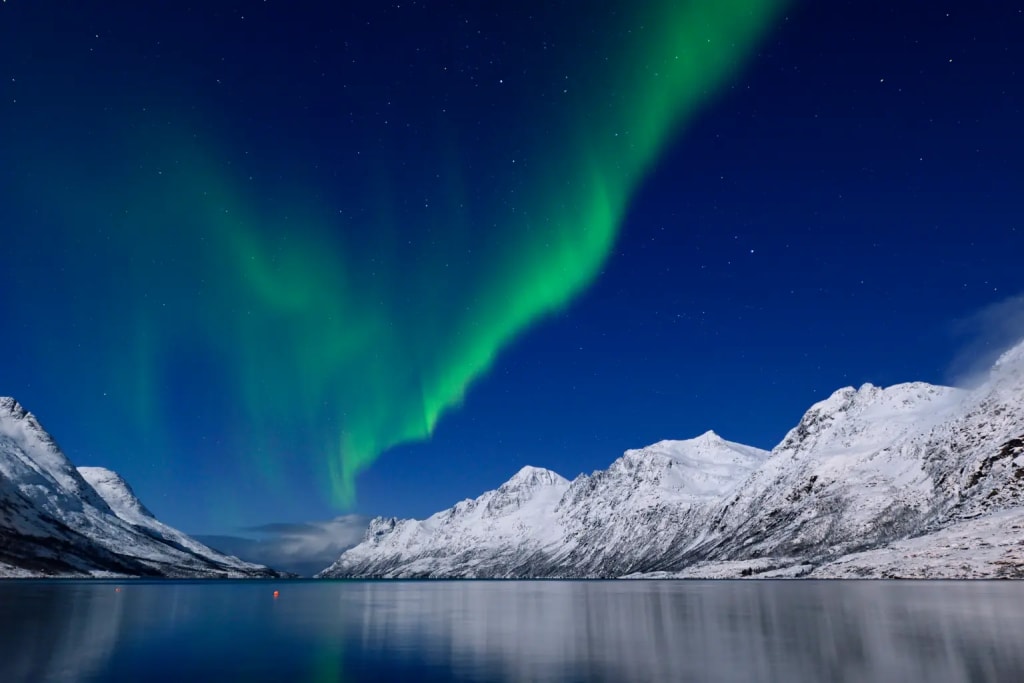
A potential geomagnetic storm may result in the mesmerizing display of the Northern Lights illuminating the skies across the United States.
NOAA's Space Weather Prediction Center has issued a warning that the Earth may experience further geomagnetic impacts following the recent significant solar flare. A Geomagnetic Storm Watch has been issued due to increased solar activity, which is expected to continue until at least Sunday, December 17. Experts have observed multiple coronal mass ejections from the Sun, resulting in the release of plasma particles towards Earth. NOAA has stated that these CMEs are likely to cause minor to moderate geomagnetic storm conditions on December 16-17. Early indications suggest that the event may reach a value of 6 on the Kp index scale, which ranges from 0 to 9.
The dancing hues of green, red, and even purple have been witnessed in the past during events of this scale, spanning from Seattle to Minneapolis and Buffalo, New York.
However, it is important to note that clouds and light pollution can hinder the visibility of these mesmerizing auroras and limit the areas from where they can be seen.
In the case of an event being underestimated, there is a possibility for communities located further south to catch a glimpse of the enchanting northern lights. A solar event of greater magnitude would extend the reach of this captivating light display to cities like Chicago, Detroit, Green Bay, and Des Moines, Iowa.
The northern lights have been observed from Minneapolis to Buffalo in the past when there was geomagnetic activity of this magnitude. This current geomagnetic storm not only produces auroras but also has the potential to affect power grids, spacecraft, and communication equipment.
According to NOAA, there is a possibility of electric transformer damage and radio signals may experience fading during a long-duration event.
As per the latest update, the event is predicted to reach a level of G2 on NOAA's 5-point scale of geomagnetic activity.
The power grids and communication equipment may experience interference due to the geomagnetic storm.
As Australia grapples with floods, numerous individuals have been advised to seek higher ground.
Australian authorities have issued a warning to residents in north Queensland state to relocate to higher ground due to the risk of flooding caused by heavy rainfall. The state capital, Brisbane, is approximately 1,700 km (1,060 miles) south of Cairns, a popular tourist destination with a population of around 170,000. Queensland Fire and Emergency Services have advised residents in affected areas to take immediate action and move to safer locations as flooding is expected to persist with the approaching high tide and ongoing rainfall. This warning is one of several emergency alerts issued for parts of north Queensland.
Ex-Tropical Cyclone Jasper brought about severe flooding due to heavy rainfall, resulting in widespread power outages and the need for evacuations. The Australian weather forecaster issued a warning of "dangerous and life-threatening flash flooding" in Cairns, a significant entry point to the Great Barrier Reef. They also anticipated that water levels on Sunday could surpass the previous record flood peak of 4.1m (13.45 feet) set in 1971. The Cairns Local Disaster Management Group reported that numerous homes, buildings, roads, and bridges had been submerged by
The agency issued a statement warning that the area may experience a loss of power, water, sewerage, and telephone services. Additionally, there has been significant flooding in Daintree Village, located approximately 120 km north of Cairns. The weather forecaster reported that around 350mm (13.8 inches) of rain had fallen since 9 a.m. on Saturday. Dean Narramore, a spokesperson for the forecaster, stated that the weather system had stalled but there is a possibility of it moving west overnight, which could result in reduced rainfall in Cairns and its surrounding areas.
Australia's eastern region has experienced frequent flooding in recent years, including devastating "once in a century" floods that submerged the neighboring Northern Territory in January. These floods occurred during a prolonged La Nina weather phenomenon. Presently, Australia is facing the challenges of an El Nino weather event, which is commonly linked to severe occurrences like wildfires, cyclones, droughts, and scorching heatwaves. An example of such a heatwave occurred last Saturday, affecting various parts of the country.
About the Creator
Enjoyed the story? Support the Creator.
Subscribe for free to receive all their stories in your feed. You could also pledge your support or give them a one-off tip, letting them know you appreciate their work.





Comments
There are no comments for this story
Be the first to respond and start the conversation.